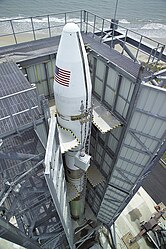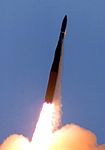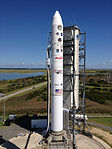Minotaur (rocket family)


The Minotaur is a family of United States solid-fuel launch vehicles repurposed from retired Minuteman and Peacekeeper model intercontinental ballistic missiles. Built by Northrop Grumman under the Space Force's Rocket Systems Launch Program, these vehicles are used for various space and test launch missions.
The Minotaur family consists of four main variants: the Minotaur I, primarily used for launching small satellites into low Earth orbit; the Minotaur II, used as a primarily used suborbital target vehicle; the Minotaur IV, a small-lift launch vehicle; and the Minotaur V, capable of reaching higher orbits, including geostationary transfer orbit and trans-lunar trajectories. Minotaur I and II are derived from the Minuteman missile, while Minotaur IV, V, and the cancelled Minotaur III are based on the Peacekeeper ICBM.
Vehicles
[edit]Minotaur-C (Taurus)
[edit]The Taurus launch vehicle, later renamed [1] Minotaur-C (for "Minotaur-Commercial"), was the first of the Minotaur vehicle family, and the first ground-launched orbital booster developed by Orbital Sciences Corporation (OSC), derived by adding a solid booster stage to the air-launched Pegasus rocket.
The first flight, sponsored by DARPA, was in 1994. After a series of failures between 2001 and 2011, the launch vehicle was rebranded as Minotaur-C in 2014. Due to laws against selling government equipment, the Minotaur-C is the only available Minotaur launch vehicle for commercial launches.[citation needed]
Minotaur I
[edit]
The original Minotaur launch vehicle, consisting of an M55A1 first stage, SR19 second stage, Orion 50XL third stage, Orion 38 fourth stage, and optional HAPS fifth stage for velocity trim and multiple payload deployment. Payload 580 kg to a 185 km, 28.5° orbit from Cape Canaveral; or 310 kg to a 740 km Sun-synchronous orbit (SSO) from Vandenberg.[2]
Minotaur II
[edit]A suborbital target vehicle, essentially consisting of a Minuteman II with Orbital guidance and control systems. Consists of M55A1 first stage, SR19 second stage, and M57 third stage. Payload 460 kg on 6700 km suborbital trajectory.[2]
Minotaur III
[edit]
A suborbital target vehicle, consisting of an SR118 first stage, SR119 second stage, SR120 third stage, and Super HAPS fourth stage. Payload 3060 kg on a 6700 km suborbital trajectory.[2] The vehicle's development was cancelled and the Minotaur III was never flown.[citation needed]
Minotaur IV
[edit]
The Minotaur IV combines U.S. government-furnished solid rocket motors from decommissioned Peacekeeper ICBMs with technologies from other Orbital-built launch vehicles, including the Minotaur I, Pegasus, and Taurus. The Minotaur IV launch vehicle consists of an SR118 first stage, SR119 second stage, SR120 third stage, and Orion 38 fourth stage. Payload 1735 kg to a 185 km, 28.5° orbit from Cape Canaveral.
The first Minotaur IV was launched 22 April 2010 from Vandenberg Air Force Base in California.[3] This vehicle is also being developed to accommodate the Conventional Prompt Global Strike (CPGS) mission for the Air Force.
Minotaur V
[edit]
The Minotaur V is a five-stage version based on the Minotaur IV+. It has an additional upper stage for small geostationary transfer orbit (GTO), lunar, and interplanetary missions.
NASA's Lunar Atmosphere and Dust Environment Explorer (LADEE) mission was launched on the first Minotaur V, from the Wallops Island, Virginia launch site at 03:27 UTC on 7 September 2013. The Minotaur launched the LADEE spacecraft into a highly elliptic orbit where it can phase and time its trajectory burn to the moon.[4]
Minotaur VI
[edit]The Minotaur VI is a five-stage launch vehicle proposed by Northrop Grumman that, as of 2024, has not flown. Minotaur VI is based on the Minotaur IV+, adding a second SR-118 first stage to increase performance.[5] A further enhanced variant, Minotaur VI+, is also proposed for beyond low Earth orbit missions using an added Star 37FM sixth stage motor. For example, Minotaur VI+ can send up to 300 kilograms (660 lb) of payload to Mars.
Launch statistics
[edit]Rocket configurations
[edit]- Minotaur-C
- Minotaur I
- Minotaur II
- Minotaur II+
- Minotaur IV
- Minotaur IV Lite
- Minotaur IV HAPS
- Minotaur IV+
- Minotaur V
Launch sites
[edit]Launch outcomes
[edit]- Success
- Failure
- Planned
Launch history
[edit]
1994[edit] | |||||||
| Flight No. | Date and time (UTC) | Rocket configuration | Launch site | Payload | Orbit | Customer | Launch outcome |
|---|---|---|---|---|---|---|---|
| 1 | 13 March 1994 22:32 |
Minotaur-C | Vandenberg, SLC-576E | STEP Mission 0 and DARPASAT | USAF/DARPA[6][7] | Success | |
1998[edit] | |||||||
| Flight No. | Date and time (UTC) | Rocket configuration | Launch site | Payload | Orbit | Customer | Launch outcome |
| 2 | 10 February 1998 13:20 |
Minotaur-C | Vandenberg, SLC-576E | GFO and Orbcomm (satellites 11,12) | Success | ||
| 3 | 3 October 1998 10:04 |
Minotaur-C | Vandenberg, SLC-576E | Space Technology Experiment (STEX) | NRO | Success | |
1999[edit] | |||||||
| Flight No. | Date and time (UTC) | Rocket configuration | Launch site | Payload | Orbit | Customer | Launch outcome |
| 4 | 21 December 1999 07:13 |
Minotaur-C | Vandenberg, SLC-576E | KOMPSAT and ACRIMSAT | Success | ||
2000[edit] | |||||||
| Flight No. | Date and time (UTC) | Rocket configuration | Launch site | Payload | Orbit | Customer | Launch outcome |
| 5 | 27 January 2000 03:03:06 |
Minotaur I | Vandenberg, SLC-8 | JAWSat (P98-1) (FalconSat1 / ASUSat1 / OCSE / OPAL) | LEO | Success | |
| 6 | 12 March 2000 09:29 |
Minotaur-C | Vandenberg, SLC-576E | Multispectral Thermal Imager (MTI) | Success | ||
| 7 | 28 May 2000 20:00 |
Minotaur II | Vandenberg, LF-06 | OSP-TLV Missile Defense Technology Demonstrator | Suborbital | Success | |
| 8 | 19 July 2000 20:09:00 |
Minotaur I | Vandenberg, SLC-8 | MightySat II.1 (Sindri, P99-1) / MEMS 2A / MEMS 2B | LEO | Success | |
2001[edit] | |||||||
| Flight No. | Date and time (UTC) | Rocket configuration | Launch site | Payload | Orbit | Customer | Launch outcome |
| 9 | 21 September 2001 18:49 |
Minotaur-C | Vandenberg, SLC-576E | Orbview-4/QuikTOMS | Failure | ||
| 10 | 4 December 2001 04:59 |
Minotaur II | Vandenberg, LF-06 | TLV-1 IFT-7 GMDS target mission | Suborbital | Success | |
2002[edit] | |||||||
| Flight No. | Date and time (UTC) | Rocket configuration | Launch site | Payload | Orbit | Customer | Launch outcome |
| 11 | 16 March 2002 02:11 |
Minotaur II | Vandenberg, LF-06 | TLV-2 IFT-8 GMDS target mission | Suborbital | Success | |
| 12 | 15 October 2002 02:01 |
Minotaur II | Vandenberg, LF-06 | TLV-3 GMDS target mission | Suborbital | Success | |
| 13 | 11 December 2002 08:26 |
Minotaur II | Vandenberg, LF-06 | TLV-4 GMDS target mission | Suborbital | Success | |
2004[edit] | |||||||
| Flight No. | Date and time (UTC) | Rocket configuration | Launch site | Payload | Orbit | Customer | Launch outcome |
| 14 | 20 May 2004 17:47 |
Minotaur-C | Vandenberg, SLC-576E | ROCSAT-2 | Success | ||
2005[edit] | |||||||
| Flight No. | Date / time (UTC) | Rocket, Configuration |
Launch site | Payload | Orbit | Customer | Launch outcome |
| 15 | 11 April 2005 13:35:00 |
Minotaur I | Vandenberg, SLC-8 | XSS-11 | LEO | Success | |
| 16 | 22 September 2005 19:24:00 |
Minotaur I | Vandenberg, SLC-8 | Streak (STP-R1) | LEO | Success | |
2006[edit] | |||||||
| Flight No. | Date and time (UTC) | Rocket configuration | Launch site | Payload | Orbit | Customer | Launch outcome |
| 17 | 15 April 2006 01:40:00 |
Minotaur I | Vandenberg, SLC-8 | COSMIC (FORMOSAT-3) | LEO | Success | |
| 18 | 16 December 2006 12:00 |
Minotaur I | MARS, LP-0B | TacSat-2 / GeneSat-1 | LEO | Success | |
2007[edit] | |||||||
| Flight No. | Date and time (UTC) | Rocket configuration | Launch site | Payload | Orbit | Customer | Launch outcome |
| 19 | 21 March 2007 04:27 |
Minotaur II | Vandenberg, LF-06 | TLV-5 FTX-02 SBR target mission | Suborbital | Success | |
| 20 | 24 April 2007 06:48 |
Minotaur I | MARS, LP-0B | NFIRE | LEO | Success | |
| 21 | 23 August 2007 08:30 |
Minotaur II+ | Vandenberg, LF-06 | TLV-7 Mission 2a sensor target for NFIRE satellite | Suborbital | Success | |
2008[edit] | |||||||
| Flight No. | Date and time (UTC) | Rocket configuration | Launch site | Payload | Orbit | Customer | Launch outcome |
| 22 | 24 September 2008 06:57 |
Minotaur II+ | Vandenberg, LF-06 | TLV-8 Mission 2b sensor target for NFIRE satellite | Suborbital | Success | |
2009[edit] | |||||||
| Flight No. | Date and time (UTC) | Rocket configuration | Launch site | Payload | Orbit | Customer | Launch outcome |
| 23 | 24 February 2009 09:55 |
Minotaur-C | Vandenberg, SLC-576E | Orbiting Carbon Observatory[8] | Failure | ||
| 24 | 19 May 2009 23:55 |
Minotaur I | MARS, LP-0B | TacSat-3 / PharmaSat / AeroCube 3 / HawkSat I / CP6 | LEO | Success | |
2010[edit] | |||||||
| Flight No. | Date and time (UTC) | Rocket configuration | Launch site | Payload | Orbit | Customer | Launch outcome |
| 25 | 22 April 2010 23:00 |
Minotaur IV Lite | Vandenberg, SLC-8 | HTV-2a hypersonic research spacecraft | Suborbital | Success | |
| 26 | 26 September 2010 04:41 |
Minotaur IV | Vandenberg, SLC-8 | SBSS | SSO | Success | |
| 27 | 20 November 2010 01:25 |
Minotaur IV HAPS | Kodiak Island, LP-1 | STP-S26 (FASTRAC-A / FASTRAC-B / FalconSat-5 / FASTSAT / O/OREOS / RAX) | LEO | Success | |
2011[edit] | |||||||
| Flight No. | Date and time (UTC) | Rocket configuration | Launch site | Payload | Orbit | Customer | Launch outcome |
| 28 | 6 February 2011 12:26 |
Minotaur I | Vandenberg, SLC-8 | NROL-66 | LEO | Success | |
| 29 | 4 March 2011 10:09 |
Minotaur-C | Vandenberg, SLC-576E | Glory, KySat-1, Hermes, and Explorer-1 [PRIME] | Failure[9] | ||
| 30 | 30 June 2011 03:09 |
Minotaur I | MARS, LP-0B | ORS-1 | LEO | Success | |
| 31 | 11 August 2011 14:45 |
Minotaur IV Lite | Vandenberg, SLC-8 | Falcon Hypersonic Technology Vehicle 2 (HTV-2b) | Suborbital | Success | |
| 32 | 27 September 2011 15:49 |
Minotaur IV+ | Kodiak Island, LP-1 | TacSat-4 | MEO | Success | |
2013[edit] | |||||||
| Flight No. | Date and time (UTC) | Rocket configuration | Launch site | Payload | Orbit | Customer | Launch outcome |
| 33 | 7 September 2013 03:27 |
Minotaur V | MARS, LP-0B | LADEE | HEO | Success | |
| 34 | 20 November 2013 01:15 |
Minotaur I | MARS, LP-0B | ORS-3 (STPSat-3 along with 28 additional cubesats) | LEO | Success[10][11] | |
2017[edit] | |||||||
| Flight No. | Date and time (UTC) | Rocket configuration | Launch site | Payload | Orbit | Customer | Launch outcome |
| 35 | 26 August 2017 06:04 |
Minotaur IV | Cape Canaveral, SLC-46 | ORS-5 | LEO | Success | |
| 36 | 31 October 2017 21:37 |
Minotaur-C | Vandenberg, SLC-576E | SkySat × 6, Flock-3m × 4 | Success | ||
2020[edit] | |||||||
| Flight No. | Date and time (UTC) | Rocket configuration | Launch site | Payload | Orbit | Customer | Launch outcome |
| 37 | 15 July 2020 13:46 |
Minotaur IV | MARS, LP-0B | NROL-129 (USA 305 to USA 308)[12] | LEO | NRO | Success |
2021[edit] | |||||||
| Flight No. | Date and time (UTC) | Rocket configuration | Launch site | Payload | Orbit | Customer | Launch outcome |
| 38 | 15 June 2021 13:35[13] |
Minotaur I | MARS, LP-0B | NROL-111 (USA 316 to USA 318)[14] | LEO | NRO | Success |
2022[edit] | |||||||
| Flight No. | Date and time (UTC) | Rocket configuration | Launch site | Payload | Orbit | Customer | Launch outcome |
| 39 | 7 July 2022 06:01[15] |
Minotaur II+ | Vandenberg, TP-01 | Mk21A reentry vehicle[16] | Suborbital | AFNWC | Failure |
2024[edit] | |||||||
| Flight No. | Date and time (UTC) | Rocket configuration | Launch site | Payload | Orbit | Customer | Launch outcome |
| 40 | 18 June 2024 07:01[17] |
Minotaur I | Vandenberg, TP-01 | Mk21A reentry vehicle[18] | Suborbital | AFNWC | Success |
Planned launches
[edit]| Date and time (UTC)[19] | Rocket configuration | Launch site | Payload | Orbit | Customer |
|---|---|---|---|---|---|
| 2024 | Minotaur IV | Vandenberg, SLC-8 | NROL-174 | LEO | NRO |
| May 2025 | Minotaur IV | Vandenberg, SLC-8 | USSF-261S-A (EWS-OD 1)[20][21] | LEO | U.S. Space Force |
| Sep 2025 | Minotaur IV | Vandenberg, SLC-8 | STPSat-7[22] | LEO | U.S. Space Force |
See also
[edit]- Dnepr, a converted Soviet ICBM often used for commercial satellite launches
- Modified Minotaur IV, Ascent Abort-2 (AA-2), was a suborbital flight to test the Launch Abort System (LAS) of NASA's Orion spacecraft. The suborbital flight used a modified Minotaur IV, launched 2 July 2019, at 11:00 UTC from CCAFS SLC-46. The suborbital flight was a success. Reference: Wikipedia article Ascent Abort-2.
References
[edit]- ^ Stephen Clark, "Taurus rocket on the market with new name, upgrades", Spaceflight Now 24 February 2014
- ^ a b c "Minotaur". Encyclopedia Astronautix. Archived from the original on 8 May 2009.
- ^ "Minotaur IV". Orbital Sciences Corporation.
- ^ Culler, Jessica (16 June 2015). "LADEE - Lunar Atmosphere Dust and Environment Explorer". NASA. Retrieved 1 August 2017.
 This article incorporates text from this source, which is in the public domain.
This article incorporates text from this source, which is in the public domain.
- ^ "Orbital ATK" (PDF). Orbital Sciences Corporation. Retrieved 1 August 2017.
- ^ "DARPASAT". space.skyrocket.de. Retrieved 15 July 2020.
- ^ "Encyclopedia Astronautica: TAOS". Encyclopedia Astronautica. Archived from the original on 13 June 2017. Retrieved 27 August 2011.
- ^ "OCO". Orbital Sciences Corporation.
- ^ "Taurus rocket nose shroud dooms another NASA satellite". Spaceflight Now, March 2011.
- ^ Powell, Rebecca (16 April 2015). "Air Force Minotaur Rocket Launching from Virginia November 19". Nasa.gov. Archived from the original on 11 November 2020. Retrieved 1 August 2017.
- ^ "ORS-3 and STPSat-3 Successfully Launched". Losangeles.af.mil. Retrieved 1 August 2017.
- ^ Krebs, Gunter (25 August 2021). "USA 305, ..., 308 (NROL 129 PL1, ..., 4)". Gunter's Space Page. Retrieved 2 September 2021.
- ^ "Northrop Grumman Successfully Launches Minotaur I Rocket for the National Reconnaissance Office". Northrop Grumman. 15 June 2021. Retrieved 2 September 2021.
- ^ Krebs, Gunter (24 June 2021). "USA 316, 317, 318 (NROL 111)". Gunter's Space Page. Retrieved 2 September 2021.
- ^ Scully, Janene (7 July 2022). "Missile Test Ends in Explosion Seconds After Launch from Vandenberg SFB". Noozhawk. Retrieved 7 July 2022.
- ^ Martinez-Pogue, Jade (6 July 2022). "Test rocket launch scheduled from Vandenberg Space Force Base Thursday morning". KEYT-TV. Retrieved 6 July 2022.
- ^ "Mk21A RV TEST LAUNCH SHOWCASES READINESS". Vandenberg Space Force Base. 18 June 2024. Retrieved 29 June 2024.
- ^ Hadley, Greg (18 June 2024). "Air Force, Lockheed Test New Reentry Vehicle for Sentinel ICBM". Air & Space Forces Magazine. Retrieved 29 June 2024.
- ^ Baylor, Michael. "Upcoming Launches: SpaceX". Next Spaceflight. Retrieved 16 August 2024.
- ^ Erwin, Sandra (25 May 2023). "Northrop Grumman wins $45 million Space Force contract to launch small weather satellite". SpaceNews. Retrieved 19 May 2024.
- ^ https://www.ssc.spaceforce.mil/LinkClick.aspx?fileticket=-vdVwK15vfM%3d&portalid=3 [bare URL]
- ^ "NRL LARADO Instrument to Detect Lethal Orbital Debris, Integrated on STP Satellite".
